12 Flowers to Plant That Bloom All Summer to Keep Your Garden Vibrant

This post follows our research editorial guidelines.

There’s a lot to love about summer. The days are longer. The weather’s warmer and if you’re anything like me, you’re excited to spend more time outside tending to your garden and enjoying the fruits (and vegetables) of your labor.

If you’re a gardening enthusiast or simply looking to add some color and beauty to your outdoor space this summer, then you’ll want to see my list of the top 12 summer flowers to grow this year. Let’s dig in!
Quickly Find Flowers That Bloom All Summer
1. Garden Phlox (Phlox paniculata)
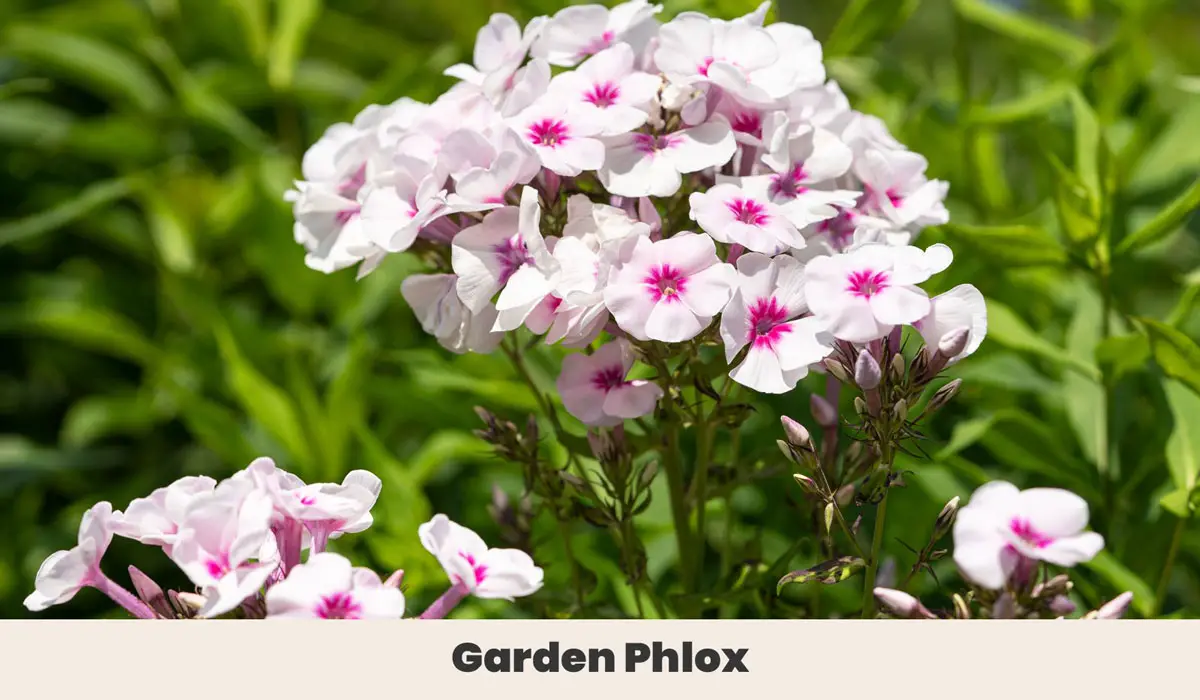
If you’re looking for the best flowers to plant that will bloom all season long, look no further than the Garden Phlox. This is a gorgeous, vibrant flower that commonly comes in shades of pink and lavender. However, Garden Phlox can also be white and even a sunny salmon color.
In addition to their gorgeous hue, Garden Phlox also attract butterflies and hummingbirds, making them an excellent addition to your garden bed.
These colorful flowers typically bloom in mid to late summer but can bloom as early as mid-fall, as well. They prefer partial to full sunlight, neutral pH soil level, and need soil that is well-draining. You can either buy soil that is already well-draining, or add a few small pebbles to your garden bed.
Even though Garden Phlox can tolerate summer heat, they don’t do well with extreme humidity. So, if you reside anywhere in the South, this may not be the best flower to add to your garden. However, if you reside on the East Coast, it’s the perfect flower to add some vibrant color to your garden.
| Botanical Name: | Phlox paniculata |
| Growth Rate: | 2-3′ tall |
| Native Range: | Native to the Eastern United States |
| Hardiness Zones: | 4-8 |
| Soil Needs: | Moist, fertile soil with sufficient drainage |
| Blooming Period | Summer to mid-fall |
| Water needs: | 1″ of water a week during the growing season |
2. Perennial Geranium (Geranium bohemicum)
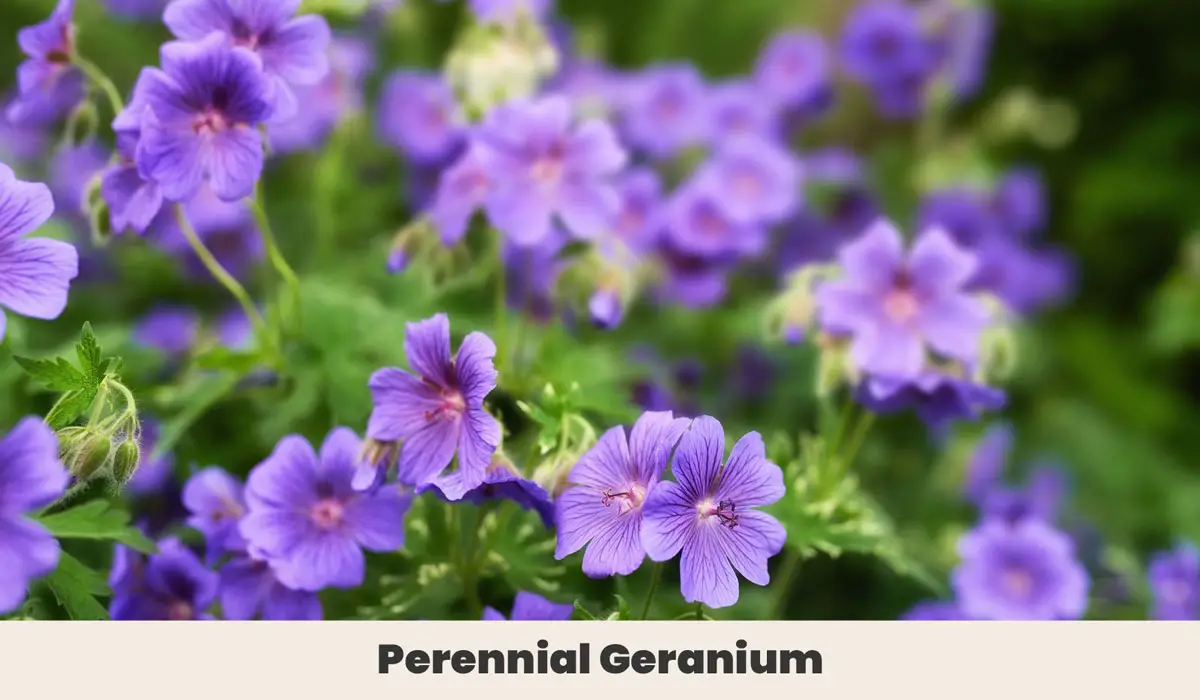
When you think of a classic summer flower, chances are you think of Perennial Geraniums. These summer bloomers are low-maintenance red, purple, and white flowers that will pop up every year once planted in your summer garden. In other words, they’re a perennial, which means that they will bloom for more than one growing season, as long as they’re taken care of.
Companion Planting Tip❤️
Perennial Geraniums take the top spot in this list for the best ability to adapt to their conditions. They will grow well in a sunny lot of a border garden or in a dimly lit woodland garden. Try growing Perennial Geraniums next to Roses, their strong scent will repel Japanese beetles, a common pest for Roses.
Perennial Geraniums do best in either full or partial shade, as well as in a well-draining soil. If you want some plant variety of summer, the Perennial Geranium offers you the best options. Here’s how to care for your flowers as well:
| Botanical Name: | Geranium bohemicum |
| Growth Rate: | 6-36′ tall and up to 3′ wide |
| Native Range: | Southern Africa and all temperate locations worldwide |
| Hardiness Zones: | 3-9 |
| Soil Needs: | Medium moisture, well-draining soil |
| Blooming Period | Spring-fall, depending on the variety |
| Water needs: | Water when soil is dry |
3. Hydrangea (Hydrangeaceae)

If you’re looking for a low light perennial flower to add to your garden, look no further than the Hydrangea.
Hydrangeas come in a wide variety of colors, including pink, white, green, and blue. Interestingly enough, the colors these flowers come in depend on the acidity level of the soil. The more alkaline the soil is, the brighter the flower head will be (i.e. pink and white). Once in bloom Hydrangeas can be brought inside for weeks at a time.
| Botanical Name: | Hydrangeaceae |
| Growth Rate: | Up to 15′ tall |
| Native Range: | North and South Americas, Asia |
| Hardiness Zones: | 5-9 |
| Soil Needs: | Well-draining soil with compost and/or organic matter |
| Blooming Period | Spring, summer, and early fall |
| Water needs: | Water once or twice a week during the growing season |
4. Summer Snapdragon (Angelonia angustifolia)
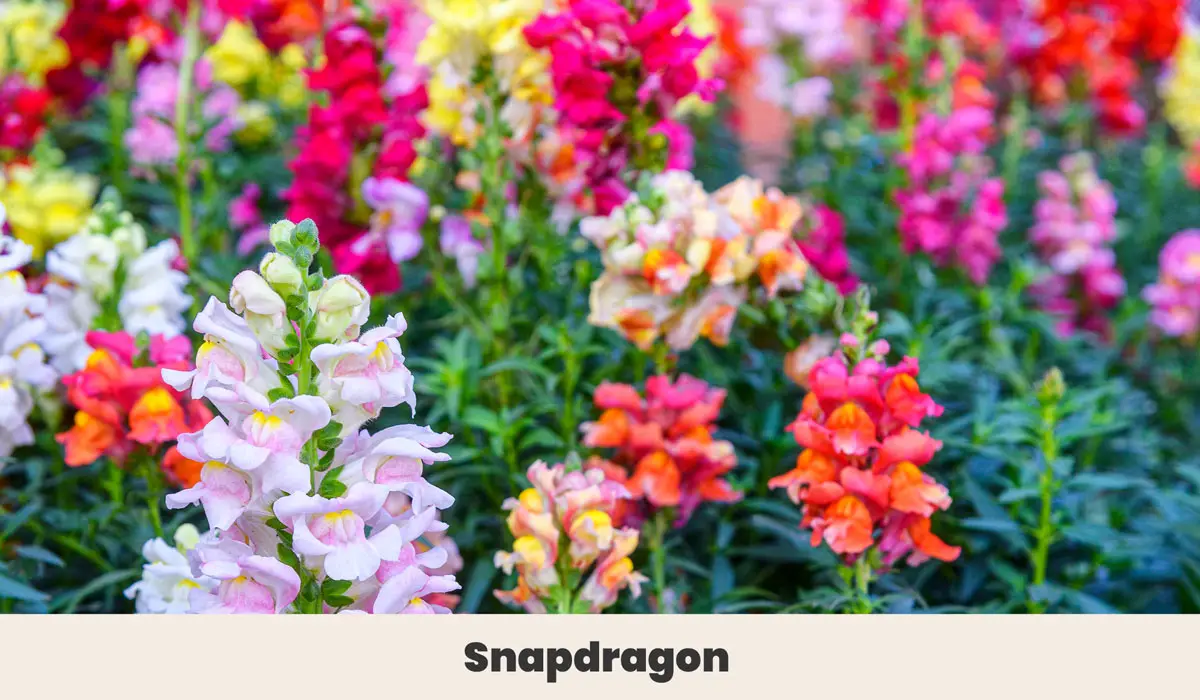
No other flower can make you smile as much as the Summer Snapdragon. This full sun annual flower is a great addition to your garden because of how vibrant they are. Coming in bright shades of purple, pink, white, and blue, these are pollinating flowers that attract bees and support other wildlife.
Best for heat tolerance☀️
The Summer Snap Dragon ranks highest on this list of flowers for their ability to tolerate heat. In fact, while other flowers begin to wilt, the summer snapdragon thrives in the hot summer sun. Be sure to look for the summer variety of snapdragons since traditional Snapdragons prefer cooler temperatures.
In fact, if you are growing tomatoes in your garden, the summer snapdragon can help them grow because the bees these popular flowers attract lead to tomato pollination. These are some of the best summer flowers to veggie garden grow this year.
| Botanical Name: | Angelonia angustifolia |
| Growth Rate: | 12-36″ tall and 12-20″ wide |
| Native Range: | West Indies, South and Central Americas |
| Hardiness Zones: | 7-11 |
| Soil Needs: | Well-draining soil with organic matter |
| Blooming Period | Summer – fall |
| Water needs: | 1″ of water per week if there is no rain |
5. Queen of the Prairie (Filipendula rubra)
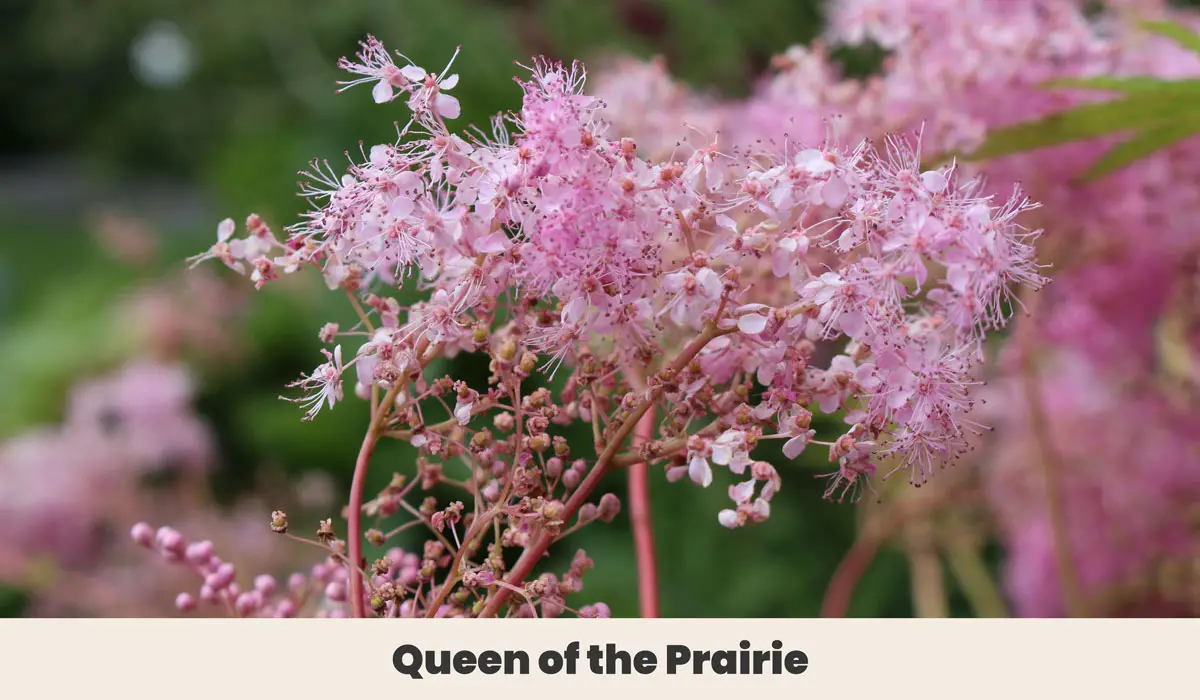
These striking flowers are easy to grow and maintain while being absolutely perfect for summer and fall. Generally speaking, you’ll have to buy these plants from your local nursery, as they’re hard to grow from seeds alone.
That being said, when they do blossom, this plant produces the most colorful, vibrant pink leaves imaginable! In fact, it’s because of how stunning these gorgeous flowers are that it has earned the name, Queen of the Prairie; it was a regal name fitting of a queen!
| Botanical Name: | Filipendula rubra |
| Growth Rate: | 3-6′ tall and 1-3′ wide |
| Native Range: | North America, specifically Pennsylvania and near Illinois |
| Hardiness Zones: | 3-9 |
| Soil Needs: | Moist, neutral, well-draining soil with mild alkaline |
| Blooming Period | Early to late summer |
| Water needs: | 1″ of water per week |
6. Tangerine Beauty Crossvine (Bignonia Capreolata)

A Tangerine Beauty Crossvine is a classic summer staple. Its orange hue is bursting with color and it does well in the heat of summer, even when temps are high.
What makes this easy-to-grow plant so popular with homeowners is that it can not only grow to be 50′ tall, but it’s a fast climber up trellises and on the ground. If you like vines and want to add color to the garden, this is a great option.
Though it can suffer from black mildew and be bothered by deer, Tangerine Beauty Crossvines are relatively pest and disease free. Here’s an overview of how to take care of these flowers all summer long:
| Botanical Name: | Bignonia capreolata |
| Growth Rate: | 30-50′ tall and 6-9′ wide |
| Native Range: | Southeastern United States |
| Hardiness Zones: | 6-9 |
| Soil Needs: | Rich, well-draining acidic soil |
| Blooming Period: | Late winter – early spring |
| Water needs: | Only water when the top 3″ of soil is dry |
7. Salvia (Salvia officinalis)

Also known as Common Sage, Salvia is a great addition to your garden, especially if you’re planning on using it in your cooking.
And speaking of your garden, if you’re growing vegetables and other herbs, this plant easily attracts bees, butterflies, and other pollinators. Salvia does best in full sun and should not be exposed to any sort of shade, as this can stunt growth. No garden design is complete without salvia, which offers some lovely purple hue.
| Botanical Name: | Salvia officinalis |
| Growth Rate: | 1-2′ tall and 2-3′ wide |
| Native Range: | The Mediterranean and Middle East |
| Hardiness Zones: | 4-10 |
| Soil Needs: | Dry or moist, well-draining soil; cannot tolerate wet soil |
| Blooming Period: | Early summer |
| Water needs: | Add 1″ of water to plants every 7-10 days |
8. Blanket Flower (Gaillardia)

Do you want to add some red flowers to your garden? What about some pretty yellow flowers? Well, when you opt for the blanket flower, you get to combine the best of both worlds.
best for drought tolerance💧
The Blanket Flower is a true champion of sun-soaked, arid landscapes. The leaves are covered in tiny hairs which help to keep moisture from escaping. The Blanket Flower also has a deep and extensive root system to seek out water when times are tough. This is the ideal flower to grow in regions where water conservation is a priority.
This daisy-like flower thrives in full sun and well-drained soil. Though they can survive in hot temperatures, extremely warm temperatures may affect how much your flowers bloom. Once you plant these pretty orange flowers, you can enjoy them for at least two growing seasons.
| Botanical Name: | Gaillardia |
| Growth Rate: | 2-3′ tall and 1-2′ wide |
| Native Range: | The Great Lakes, Great Plains, and New England |
| Hardiness Zones: | 3-10 |
| Soil Needs: | Well-draining soil |
| Blooming Period: | Summer-fall |
| Water needs: | Water once or twice a week |
9. Sea Holly (Eryngium)
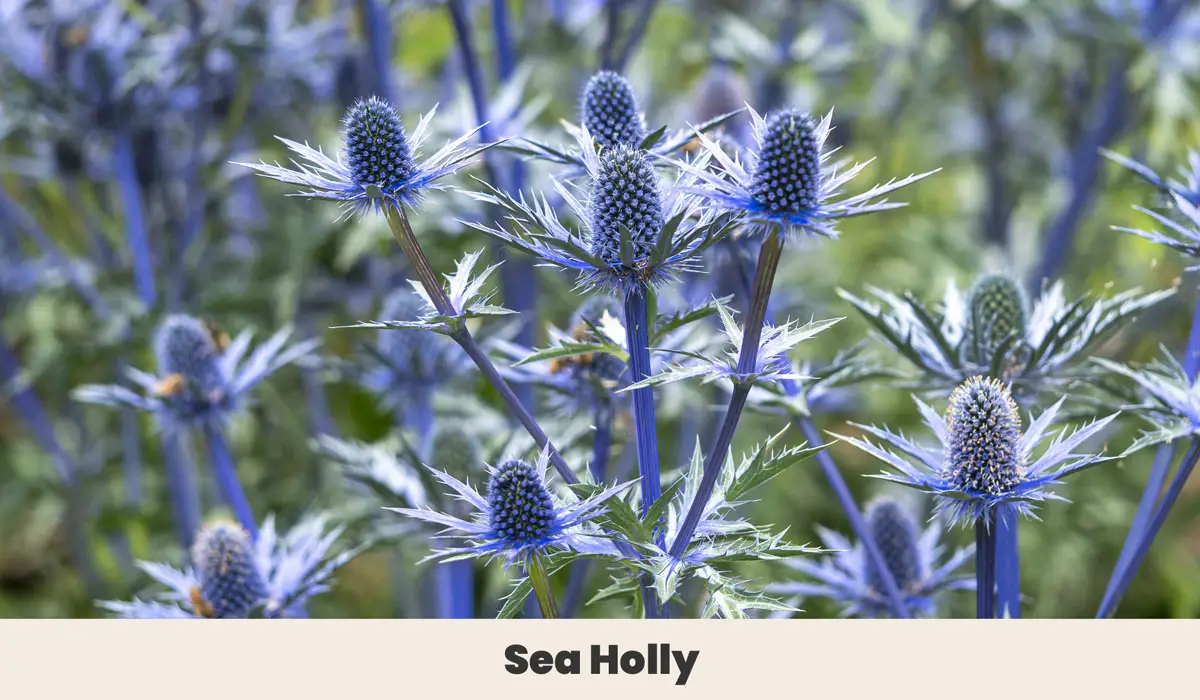
Blue flowers always add a statement to any garden and the Sea Holly is no exception. Though they’re not technically considered to be a tropical plant, it still looks like one, making them an exotic addition to your existing garden flowers.
Sea Holly is relatively easy to care for, but you may have to pay more attention to it during the first year it’s planted. The first year is when it needs the most watering (only when the soil is dry). After the first year, the plant becomes very tolerant to droughts, so it can go a long time without watering.
| Botanical Name: | Eryngium |
| Growth Rate: | 2-3′ tall, 1-2′ wide |
| Native Range: | North America |
| Hardiness Zones: | 2-10 |
| Soil Needs: | Well-draining soil |
| Blooming Period: | Summer and sometimes fall, depending on the weather |
| Water needs: | Water as needed to keep soil moist |
10. Texas Bluebell (Eustoma grandiflorum)
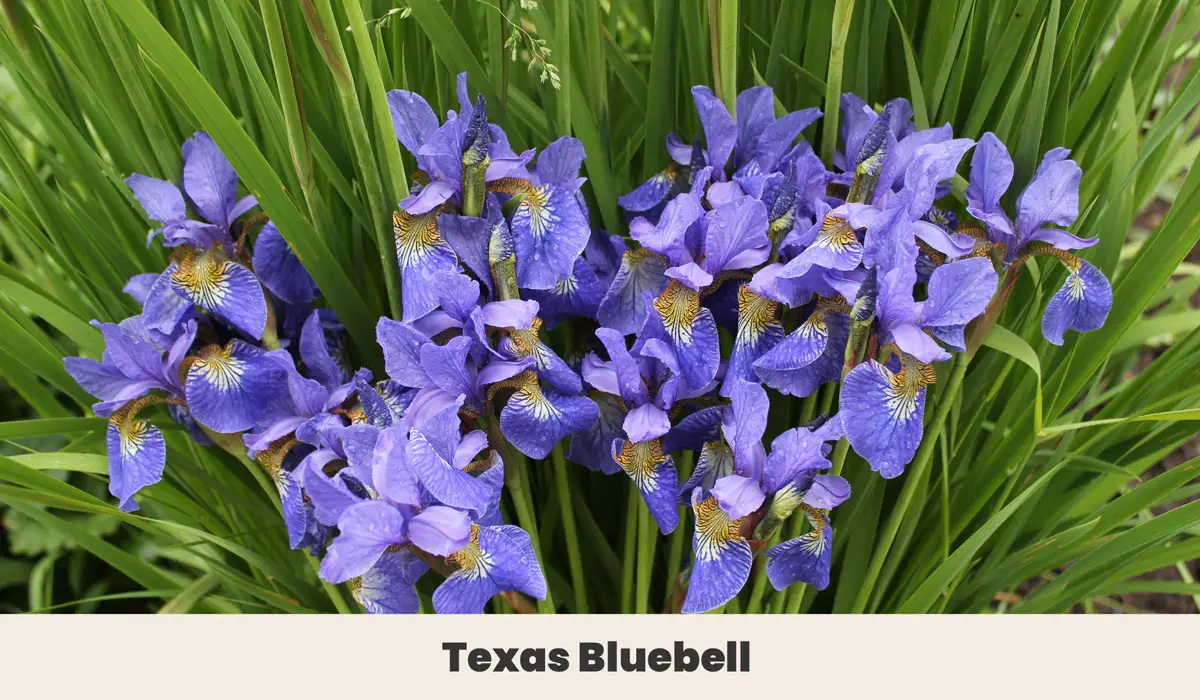
Despite having the word blue in its name, the Texas Bluebell is actually a lovely shade of purple! Growing about 2 feet tall, these flowers in purple do best when grown in partially-shaded environments.
In terms of care, these tend to require a moderate amount of work. You must always keep the soil damp and do your best to prevent common diseases such as leaf spot. The easiest way to do this is by ensuring that your Texas Bluebell plant is always growing in well-draining soil. After you’re done growing them, why not add them for some decoration in your home? Texas Bluebell make great cut flowers. Just grab your shears and trim away!
| Botanical Name: | Eustoma grandiflorum |
| Growth Rate: | 1-2′ tall |
| Native Range: | North America |
| Hardiness Zones: | 8-10 |
| Soil Needs: | Well-draining soil with little organic matter |
| Blooming Period: | Summer to the first frost of the season |
| Water needs: | Water regularly to keep soil damp |
11. Globe Amaranth (Gomphrena)

Globe Amaranths are considered to be a long bloom flower. This is because its blooming period extends from the early summer season through the first frost, which is usually around the end of fall.
During this blooming period, the Globe Amaranth is relatively low-maintenance. It only has to be watered twice a week, and is more or less free from pests and plant diseases. It’s even a deer deterrent. So, if deer have been feasting on your vegetable garden, these flowers add a bit of protection to your crops.
When these flowers bloom, expect them to be vibrant shades of pink, purple, and white.
| Botanical Name: | Gomphrena |
| Growth Rate: | 6-12″ wide, 12-24″ tall |
| Native Range: | Central America |
| Hardiness Zones: | 2-11 |
| Soil Needs: | Standard garden soil, but it can tolerate clay soil |
| Blooming Period: | Early summer to the first frost of the year |
| Water needs: | Water twice a week to saturate the plant’s roots |
12. Zinnia (Zinnia elegans)

If there’s one summer favorite you should plant in your garden, it’s a Zinnia. These pink flowers are stunning and can easily brighten up your garden. If you reside in a hot climate, then you’ll want to plant this flower in your garden because it actually handles extreme heat really well.
Though this plant is a true annual, meaning it won’t come back every year, it’s relatively low-maintenance while you are caring for it. All it needs is about an inch of water once a week to stay healthy.
| Botanical Name: | Zinnia elegans |
| Growth Rate: | 1-4′ tall and 6-18″ wide |
| Native Range: | North and South Americas |
| Hardiness Zones: | 3-10 |
| Soil Needs: | Well-draining soil that’s rich in organic matter |
| Blooming Period: | Late spring – first frost of the season |
| Water needs: | 1″ of water every 5-7 days |
Final Thoughts
Adding both annuals and perennials to your garden is the perfect way to add some color all summer long. Whether you’re looking for flowers to grow this summer or statement flowers, all of these mentioned on this list will sure to be a garden favorite.
This guide is here to help you find the best long-blooming flowers that can withstand the hot summer months, as well as how to care for them so they return next summer (and beyond).

Before you go!
11 Weeds With Attractive Yellow Flowers: Hidden gems and repeat offenders.
10 Blue Flowering Trees + Growing Guide
11 Bell-Shaped Flowers: Your Guide to Breathtaking Blossoms
11 Stunning Red Perennial Flowers That Bloom All Summer + Growing Guides